ASUS P8Z77-V Premium Review: A Bentley Among Motherboards
by Ian Cutress on August 13, 2012 10:30 AM EST- Posted in
- Motherboards
- Asus
- Z77
USB Speed
For this benchmark, we run CrystalDiskMark to determine the ideal sequential read and write speeds for the USB port using our 240 GB OCZ Vertex3 SSD with a SATA 6 Gbps to USB 3.0 converter. Then we transfer a set size of files from the SSD to the USB drive using DiskBench, which monitors the time taken to transfer. The files transferred are a 1.52 GB set of 2867 files across 320 folders – 95% of these files are small typical website files, and the rest (90% of the size) are the videos used in the Sorenson Squeeze test.
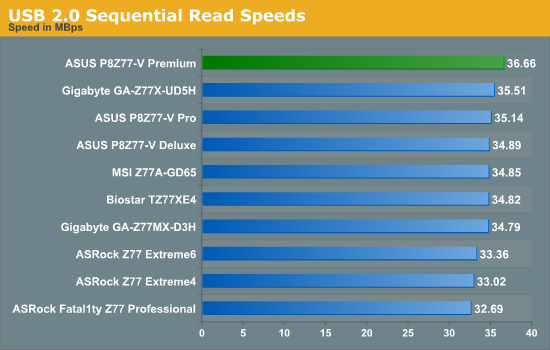
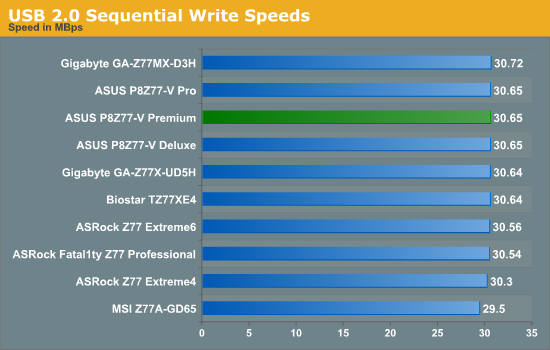
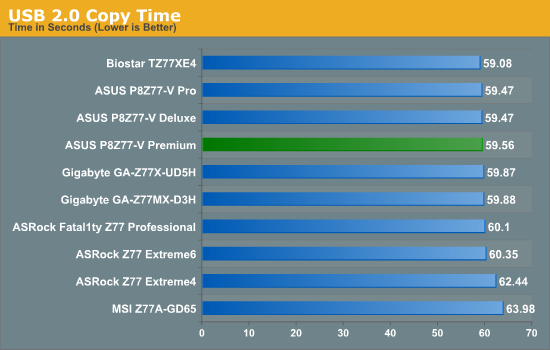
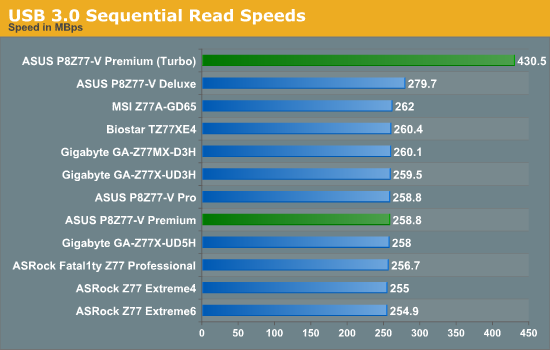

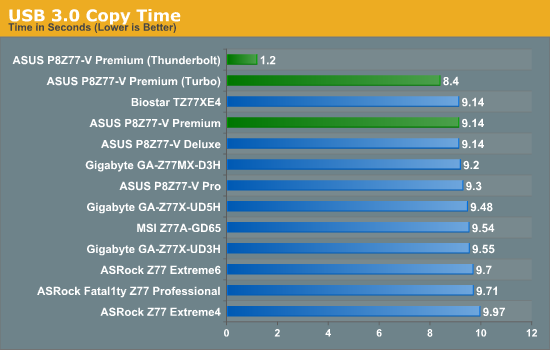
Our chipset USB testing shows the Premium in the top half of each of our graphs. Of particular note is the USB 3.0 copy test, where the Premium equals our best native USB 3.0 copy timings, and using ASUS' enhanced Turbo option on the native USB 3.0, we achieve even better performance. When attached to the ASMedia controller under UASP, the ASUS P8Z77-V Premium performs better than any other motherboard's default solution.
Also of note is our Thunderbolt result for our copy test, which comes in at 1.20 seconds. This result was erratic, sometimes going to three seconds or above. When we come to testing more Thunderbolt motherboards, we have a different copy test to probe differences between the implementations.
SATA Testing
We also use CrystalDiskMark for SATA port testing on a C300 drive. The sequential test (incompressible data) is run at the 5 x 1000 MB level. This test probes the efficiency of the data delivery system between the chipset and the drive, or in the case of additional SATA ports provided by a third party controller, the efficiency between the controller, the chipset and the drive.
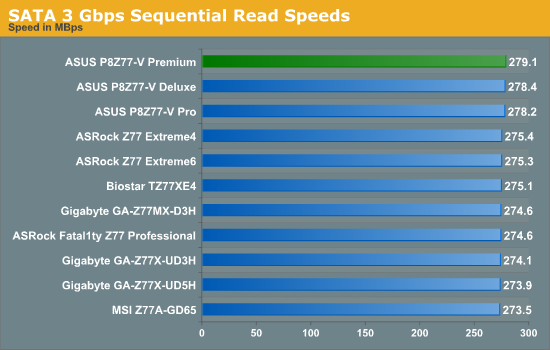
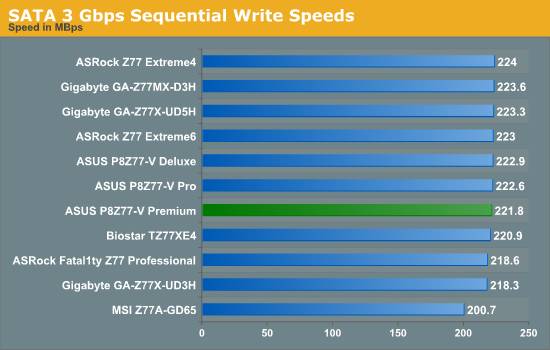
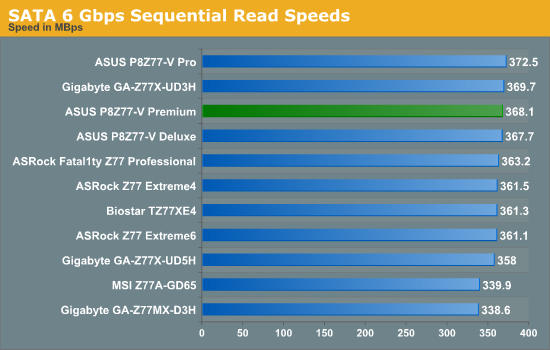
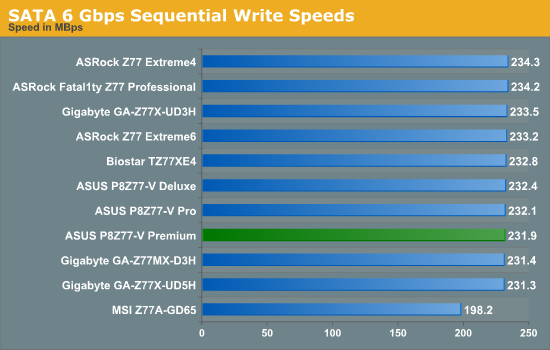
DPC Latency
Deferred Procedure Call latency is a way in which Windows handles interrupt servicing. In order to wait for a processor to acknowledge the request, the system will queue all interrupt requests by priority. Critical interrupts will be handled as soon as possible, whereas lesser priority requests, such as audio, will be further down the line. So if the audio device requires data, it will have to wait until the request is processed before the buffer is filled. If the device drivers of higher priority components in a system are poorly implemented, this can cause delays in request scheduling and process time, resulting in an empty audio buffer – this leads to characteristic audible pauses, pops and clicks. Having a bigger buffer and correctly implemented system drivers obviously helps in this regard. The DPC latency checker measures how much time is processing DPCs from driver invocation – the lower the value will result in better audio transfer at smaller buffer sizes. Results are measured in microseconds and taken as the peak latency while cycling through a series of short HD videos - under 500 microseconds usually gets the green light, but the lower the better.
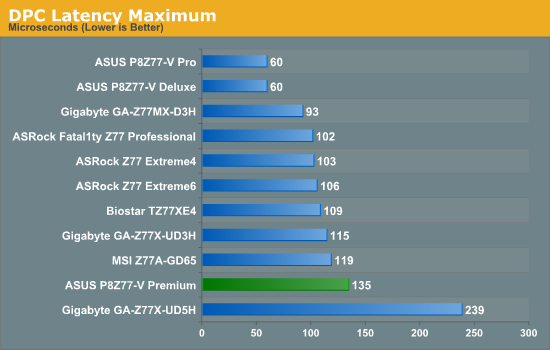
Surprisingly our ASUS P8Z77-V Premium DPC test comes in at one of the highest Z77 motherboard results, double the 60 microseconds of the ASUS P8Z77-V Pro. However, the result is still under 200 microseconds, which gives it an excellent rating.










43 Comments
View All Comments
Phynaz - Monday, August 13, 2012 - link
And so are the handful of people that would spend $450 on a motherboard.Samus - Tuesday, August 14, 2012 - link
I spent $300 on my Asus P6T (socket 1366) in December 08. I still use it today, only upgrading it with a USB 3.0 PCIe card and from a GTX285 to a GTX570, keeping it 'current'.The i7-950 and 12GB of triple-channel DDR3 keep it competitive with the upper 90% of computers made today, so I feel it was a completely worthy investment.
Who else can honestly say they've had a computer for four years and have upgraded virtually nothing aside from the video card and still have performance competitive with the fastest computers sold today?
Visual - Tuesday, August 14, 2012 - link
Um, pretty much everyone that bought any kind of quad core?Mobo has always had almost zero effect on performance to begin with, CPUs have been faster than most people need them be in the last decade or so, GPU is the only thing that matters.
This mobo is not expencive because it has any pluses in performance, but because of the extra frills and features it has... which are only worth it if you actually use them. I don't think I will need most of them currently, and can add them on to any computer if I decide to use them later on. So this mobo is not worth it for me.
pandemonium - Thursday, August 16, 2012 - link
This is pretty silly, since A LOT rides on which CPU you're using and how overclocked it is. GPUs are DEFINITELY NOT the only thing that matters and this has been proven through hundreds of reviews and comparisons all over the net.BytesMage - Tuesday, September 11, 2012 - link
Never crazy. My last build was 4 years ago. 790i SLI Ultra. I've kept him alive with GPU upgrades from 9800Gx2 in 2008 to GTX 580 3gb x2 in 2011, Memory upgrades from 4gb to 8gb. This extends life yes, but you get to the point of no return and then have to build again. I am at that place now. Mobo is very important. It is the ground floor on which everything else must stand. I have had a bad Mobo in past and can tell you that it does not matter what GPU you have if your mobo is poo. I want a feature rich, stable, OC able board with plenty of room for expansion. Price is what you pay for this. Well worth it. Why is it that no one moans (much) at $600.00 GPu but they do at $450.00 MB???? It is what it is. Where I see bad pricing is SSDs $500-600 big ones for a 512gb....Menetlaus - Monday, August 13, 2012 - link
I don't understand the inclusion of the 32GB mSATA SSD with this motherboard, even more so at the $450 price point.As the article says, anyone paying that kind of cash can easily afford a bigger and faster SSD and the 32GB is barely enough for a Win 7 install. The only way I really see it being beneficial is if it came pre-configured to work as cache (using intel rapid storage tech or similar) but there would be no way for them to know which drive to speed up as there is no point in caching a fast SSD if one was installed as the OS drive.
I really like that is has a mSATA port to allow a user to install a small form SSD, but including a 32GB drive these days is simply too small for a standalone drive and the configuration to get intel RST or similar working is not for the novice user (or so I've heard).
cjs150 - Monday, August 13, 2012 - link
I agree the mSATA seems a frivolous extra although I would give two reasons; 1. Not big enough, 128Gb mSATA would be nice though 2. only SATA 3G, the latest mSATA cards are SATA 6G but sadly not got a board to support this yet.If this is a true premium board mSATA should be SATA 6G then it would be truely quick
ASUSTechMKT - Tuesday, August 14, 2012 - link
the current mSATA spec only supports 3G as it is required to be linked to the 3G PCH port per Intel specification. Additionally see the feedback above regarding the 32GB mSATA module. Lastly a larger capacity mSATA would have considerably increased the cost which was already high especially considering all the logic some covered and some not covered in the review.Also would not in our analysis overall usage of mSATA is very low for users in the desktop space due to higher cost compared to standard 2.5inch SSDs. This is also why we integrated the solution to ensure a fully usable out of box solution for SSD caching.
AnnihilatorX - Monday, August 13, 2012 - link
The 32GB SSD may be aimed at the Intel Smart Response SSD Caching Technology for a larger mechanical HDD.One may also use it for a Linux partition I guess?
If I am to buy this, I may sell the mSATA. I wonder how much that will fetch.
Azethoth - Monday, August 13, 2012 - link
Yeah, I added a REVODRIVE 3 X2 (240GB SSD) to my Z77 build. It cost about as much as this motherboard but it doesn't need a puny 32GB cache to slow it down. My media is already on a NAS so 240GB is all I need for OS, software development and games.However next year I will definitely buy the premium LGA 2011 version, hopefully it comes with a 64GB SSD so I can add a backup drive under it.